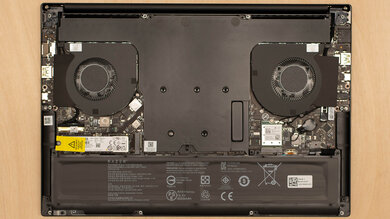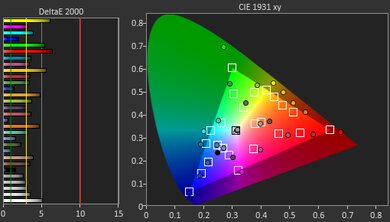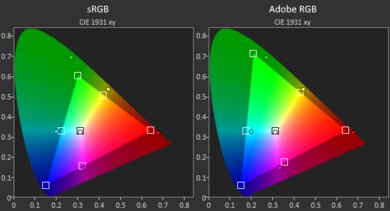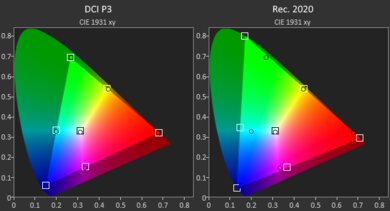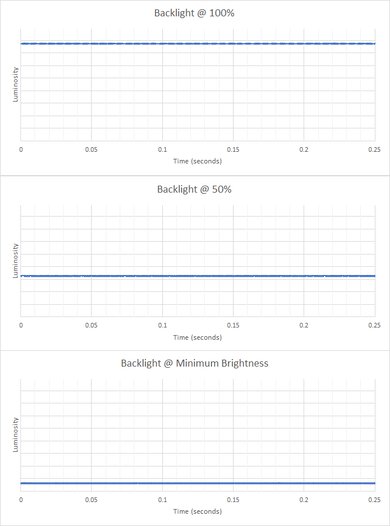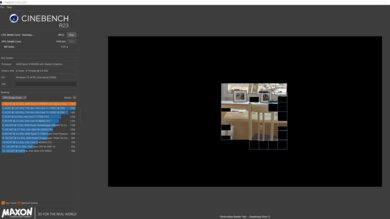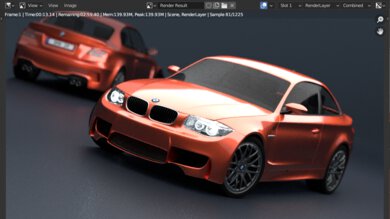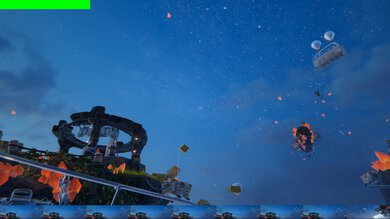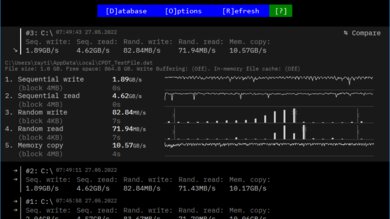The Razer Blade 14 (2022) is a premium thin and light gaming laptop. It's the smallest model of the Razer Blade lineup, with the other two being the Razer Blade 15 and 17. It replaces the Razer Blade 14 from 2021 with an AMD Ryzen 5900HX CPU paired with an NVIDIA GeForce RTX 3060, 3070, or 3080 GPU. The 2022 model retains the same display options as its predecessor, as well as the NVIDIA GeForce RTX 3060 GPU option. However, Razer upgraded the CPU to the AMD Ryzen 9 6900HX with DDR5 memory and replaced the RTX 3070 and 3080 with the 3070 Ti and 3080 Ti. The Razer Blade 14 competes directly with the ASUS ROG Zephyrus G14 (2022).
Our Razer Blade 14 has an AMD Ryen 9 6900HX CPU, an NVIDIA GeForce RTX 3070 Ti discrete GPU, 16GB of memory, and 1TB of storage. Razer offers only three pre-determined configurations. The base model has a 1080p 144Hz display paired with an NVIDIA GeForce RTX 3060. The other two models have a 1440p 165Hz display paired with an NVIDIA GeForce RTX 3070 Ti or 3080 Ti. All three models have the same CPU, memory, and storage configuration. All three GPUs have a TGP (Total Graphics Power) of 100W.
Our Verdict
The Razer Blade 14 is good for school use. It feels remarkably well built with a full aluminum chassis, and is easy to carry around thanks to its thin and light design. However, you'll have to bring its slightly bulky charger with you as the battery doesn't last long enough to get through a typical school day. The display is sharp, the keyboard feels great to type on, and the touchpad is responsive. Its AMD Ryzen CPU and NVIDIA graphics can handle nearly every type of workload, including demanding tasks like 3D graphics and animation.
- Thin and light design.
- Feels very well built.
- CPU and GPU are powerful enough to handle demanding workloads.
- Keyboard feels great to type on.
- Large and responsive touchpad.
- Battery lasts less than 8 hours of light use.
- Bulky power adapter.
The Razer Blade 14 is excellent for gaming. It's available with an FHD or QHD display, both of which have a high refresh rate and FreeSync support, and its AMD Ryzen CPU and NVIDIA discrete graphics are powerful enough to deliver smooth gameplay at high settings. There's no thermal throttling on the CPU or GPU, and the fans are reasonably quiet under load; however, the keyboard gets very hot. It has plenty of USB ports for your peripherals, as well as an HDMI 2.1 port for 4k 120Hz gaming.
- Runs games smoothly at 1440p.
- 165Hz panel with fast response time.
- Supports VRR to reduce screen tearing.
- No thermal throttling on CPU or GPU.
- Keyboard feels great to type on.
- Fast PCIe Gen 4 SSD.
- Keyboard gets hot under load.
- Limited to 16GB of memory.
The Razer Blade 14 is decent for media consumption. It's fairly portable due to its compact design, and its battery lasts a little over 6 hours of video playback, plenty of time to get through a couple of movies. The display is sharp and colorful; however, it has a relatively low contrast ratio that makes blacks appear gray in dim settings. Unfortunately, although the speakers get reasonably loud, they produce muddy mids and lack bass.
- Thin and light design.
- Sharp and colorful display.
- Battery lasts around 6 hours of video playback.
- Blacks look gray in dim settings.
- Speakers sound bad.
- Display doesn't support touch input.
The Razer Blade 14 is outstanding for use as a workstation. Its AMD Ryzen CPU and NVIDIA graphics perform well and can handle demanding tasks, like video editing and 3D animation. Also, the QHD display has full DCI P3 coverage, making it suitable for viewing and producing HDR content. It has a fast PCIe Gen 4 SSD for quick file transfer and plenty of ports for your peripherals and external displays. Unfortunately, you can only get a maximum of 16GB of memory, and the memory isn't user-upgradeable, which might be a dealbreaker for those working with large datasets.
- CPU and GPU are powerful enough to handle demanding workloads.
- No thermal throttling on CPU or GPU.
- Keyboard feels great to type on.
- Fast PCIe Gen 4 SSD.
- Wide port selection.
- Display has full DCI P3 coverage.
- Keyboard gets hot under load.
- Limited to 16GB of memory.
The Razer Blade 14 is great for business use. It feels well-built, and it's portable due to its compact design. The display provides just enough space for some light split-screen multitasking, the keyboard feels great to type on, and the touchpad tracks all movements and gestures well. The webcam's video quality is great, even though the image is a little too dark, and the microphone sounds loud and relatively clear. Its AMD Ryzen CPU and NVIDIA graphics provide more than enough processing power to handle tasks like text formatting, spreadsheets, and presentations. The battery lasts a little more than 7 hours of light use, so you'll likely have to plug it in at some point for a quick charge.
- Thin and light design.
- Feels very well built.
- CPU and GPU are powerful enough to handle demanding workloads.
- Keyboard feels great to type on.
- Wide port selection.
- Large and responsive touchpad.
- Battery lasts less than 8 hours of light use.
- Bulky power adapter.
Changelog
- Updated Dec 07, 2023: Converted to Test Bench 0.8.2.
- Updated Nov 03, 2023: Converted to Test Bench 0.8.1.
- Updated Oct 03, 2023: Added mention of the Dell Alienware m18 (2023) as an alternative with newer NVIDIA 40-series GPUs in the GPU section.
- Updated Sep 11, 2023: Added mention of the ASUS ROG Flow X13 (2023) as an alternative with a brighter display in the Brightnesssection.
Differences Between Sizes And Variants
We tested the Razer Blade 14 2022 (model RZ09-0427) with an AMD Ryzen 9 6900HX CPU, an NVIDIA GeForce RTX 3070 Ti discrete GPU, 16GB of memory, and 1TB of storage. The Razer Blade 14 is available in three pre-determined configurations; you can see them in the table below.
| Configuration 1 |
|
|---|---|
| Configuration 2 |
|
| Configuration 3 |
|
Our display and performance results are only valid for the configuration we tested. If you come across a different configuration option not listed above, or you have a similar Razer Blade 14 that doesn't correspond to our review, let us know, and we'll update it. Some tests, like black uniformity and color accuracy, may vary between individual units.
You can see our unit's label here.
Popular Laptop Comparisons
The Razer Blade 14 is among the best 14-inch gaming laptops on the market. Compared to its direct competitor, the ASUS ROG Zephyrus G14 (2022), the Blade 14 has a sturdier and more premium build, and it's available with a faster 165Hz display and more powerful GPUs to deliver smoother gameplay.
For other options, check out our recommendations for the best laptops, the best business laptops, and the best Chromebooks.
The Razer Blade 14 (2022) and the ASUS ROG Zephyrus G14 (2024) are both high-end gaming laptops that provide a similar user experience overall. It's worth noting that the Razer's speakers are significantly worse, producing a tinny, unnatural sound compared to the ASUS' full, well-balanced speaker system. Gaming performance depends on the configuration (for example, the Razer's RTX 3080Ti will still outperform the ASUS' RTX 4050). The main difference is that the newer 40-series GPUs support Frame Generation, a feature that boosts performance by inserting A.I.-generated frames. As for the display, the ASUS' OLED panel is arguably better, as it can produce deeper blacks for a better dark room viewing experience and get brighter to combat glare; however, it's limited to a 120Hz refresh rate, whereas the Razer is available with a 144Hz or 165Hz screen. Also, the ASUS' OLED display flickers, which might bother people who are sensitive to flickering.
The Razer Blade 14 (2022) and the ASUS ROG Zephyrus G14 (2022) are both thin and light 14-inch high-end gaming laptops. The Razer is a more premium-feeling device overall, and it delivers a smoother gaming experience with a faster 165Hz display and better-performing GPUs. However, the ASUS might be a better choice for productivity tasks as it has a longer battery life and a brighter display to combat glare in well-lit settings. You can also configure the ASUS with more memory, which is important for demanding workloads with large datasets.
The ASUS ROG Flow X13 (2023) and the Razer Blade 14 (2022) are both excellent high-end gaming laptops. The Flow X13 has a brighter display, a better keyboard, and a faster CPU. However, the Blade 14 has a sturdier build, a wider port selection, and longer battery life. GPU performance will depend on which configuration you get. The Flow X13 has a slight edge, as its NVIDIA 40-series GPUs support Frame Generation. It also has a proprietary PCIe port that lets you connect ASUS' ROG XG Mobile eGPU, giving you access to an NVIDIA GeForce RTX 4090 Laptop GPU.
Although the Razer Blade 14 (2022) and the Lenovo Legion 5 Gen 6 15 (2021) are both gaming laptops, they aren't in the same class. The Razer is a significantly more premium device that offers a better user experience. It has a sturdier build with a full aluminum chassis and is available with more powerful internals to provide smoother gameplay. The Razer's QHD display with full DCI P3 coverage also makes it a better option for production workloads like video editing.
Test Results

The Razer Blade 14 2022 has a clean and modern design with minimal gamer aesthetic. Other than the Razer logo on the lid, which lights up, it wouldn't look out of place in a professional working environment. It has an all-black anodized aluminum chassis with up-firing speakers and an RGB backlit keyboard. The vents are on the bottom of the laptop, along with thick rubber feet.
The Razer Blade 14's build quality is outstanding. It has a full aluminum chassis that feels solid, with no obvious flaws in the construction. The display flexes a little bit, but not the keyboard deck. Unfortunately, while the finish is fairly scratch-resistant, it's quite a fingerprint magnet, so you'll have to wipe it down often to keep it clean. The overall build is very close to an Apple MacBook but doesn't feel as premium.
The Razer Blade 14 has an outstanding hinge. It feels smooth when opening and closing the laptop, and it's easy to adjust to your preferred position. It's very stable and doesn't wobble at all. You can open the lid easily with one hand, a nice quality-of-life feature that you would expect on such a premium device.
The Razer Blade 14 is fairly compact and should fit into most bags. The power adapter is a little bulky and heavy, though still smaller than most 230W chargers.
The Razer Blade 14's serviceability is okay. Accessing the internals is easy as you only have to remove 10 T5 Torx screws before removing the bottom panel. Unfortunately, the memory isn't user-upgradeable. Opening the laptop and changing the hardware may void the manufacturer's warranty.
The Razer Blade 14 has two display options:
- 1920 x 1080 144Hz (IPS, 100% sRGB)
- 2560 x 1440 165Hz (IPS, 100% DCI P3)
Both displays look sharp at this screen size. The 1080p panel has a pixel density of 157 PPI, which is still very good. That said, it's best to get the QHD display if you plan on using the laptop for productivity, as the increased sharpness improves text clarity. The 16:9 aspect ratio is good for gaming and media consumption; however, it feels a little too short for productivity. A taller 16:10 aspect ratio would have been preferable as you won't have to scroll as much when reading a document, and it would have also shrunken its rather large bottom chin. If you want a gaming laptop with a bigger screen, check out the HP OMEN 16 (2022).
The Razer Blade 14's QHD has a high refresh rate and a fast response time, delivering a clear image in fast-moving scenes with only a tiny amount of ghosting. The 1080p 144Hz display likely has similar performance. If you want a gaming laptop with a faster 240Hz display, check out the MSI Raider GE67 HX (2022).
The Razer Blade 14's QHD display has an okay contrast ratio typical of most IPS panels. This relatively low contrast makes blacks look gray in dim settings, so it isn't ideal for dark room viewing. The 1080p panel likely has the same contrast ratio. The contrast ratio can vary between individual units, but the difference is usually minor and isn't noticeable.
The Razer Blade 14's QHD display gets reasonably bright, enough for use in most indoor settings but not for very well-lit environments or outdoors in broad daylight. It gets very dim at the lowest brightness setting, making it more comfortable to view in dark rooms. The 1080p panel likely has the same screen brightness. If you want a gaming laptop with a brighter display, check out the ASUS ROG Flow X13 (2023).
The Razer Blade 14 has decent reflection handling. Reflections aren't an issue when viewing bright content with the screen at maximum brightness; however, they're distracting when viewing dark content as the matte anti-reflective coating doesn't reduce the reflections' intensity and creates a hazy halo effect in other areas of the screen.
The Razer Blade 14 has decent black uniformity. There's no backlight bleed, but the whole screen looks more blue than gray, and it's a little patchy in some areas. Black uniformity varies between individual units due to manufacturing tolerances; you may get some backlight bleed, which is common for IPS panels. However, you can expect the rest of the screen to be fairly similar.
The Razer Blade 14 has mediocre horizontal viewing angles. The image dims and washes out fairly quickly as you move off-center. It's fine for sharing casual content with someone else, but it isn't ideal for color-critical work. The lightness is slightly higher on the left at 30 degrees than on the right, but it isn't visible and likely due to panel variance.
The Razer Blade 14 has okay vertical viewing angles. The image remains accurate until you reach a moderately steep angle from above or below. It's particularly useful in tight spaces where you can't tilt the screen to your preferred angle, like on a bus or an airplane.
The Razer Blade 14 2022 has decent color accuracy out of the box. Most colors are inaccurate because it targets a wider color space to produce more saturated colors. Some might prefer this oversaturated look; it just isn't accurate. The white balance is good overall, and the color temperature is very close to the standard 6500k target. The gamma sticks to an almost flat 2.2 instead of following the sRGB curve, making dark scenes too dark and bright scenes too bright. Color accuracy varies between individual units, but the difference is usually minimal.
The Razer Blade 14's QHD display has an outstanding color gamut. It has full coverage of the sRGB and DCI P3 color spaces, making it suitable for viewing and producing SDR and HDR content. Its Adobe RGB coverage is excellent but likely not enough for professional photo editing as it can't display saturated greens. The 1080p display only has full sRGB coverage.
The Razer Blade 14 2022 has a great keyboard. It feels spacious and has a standard layout that's easy to get used to. The keys have a good amount of travel and feel satisfyingly tactile, although they aren't the most stable. Overall, it feels great to type on, and while the operating force is a bit high, it isn't tiring over an extended period. It's a little loud but not annoying, so it shouldn't bother others in a quiet setting. It has full per-key RGB backlighting, which you can customize through Razer's Synapse software.
The Razer Blade 14 has an excellent touchpad. It's decently large, with a smooth glass surface that feels high quality. The tracking is outstanding, and there aren't any issues with palm rejection or actions like dragging and dropping. The click mechanism doesn't feel particularly satisfying, but you can click anywhere on the touchpad.
The Razer Blade 14's speakers get reasonably loud with minimal dynamic compression artifacts at max volume. However, they don't sound good as the mids are muddy, and there's no bass whatsoever. The THX 3D sound setting is on by default and makes the speakers sound subjectively worse. The speakers were tested with the setting off.
The Razer Blade 14's webcam video quality is very good. It captures a lot of fine details, with good color reproduction and only a little bit of noise. However, the image is too dark. Voices sound loud and clear over the microphone but slightly hollow.
The Razer Blade 14 has an excellent port selection. Its two USB-A ports support USB 3.2 Gen 2 data transfer speed (up to 10Gbps). The two USB-Cs are also USB 3.2 Gen 2 ports and support video output via DisplayPort 1.4. You can charge the laptop via USB-C, but only with a 20V charger with Power Delivery 3.0. There's a slot for a Kensington lock on the right side.
The Razer Blade 14 has a Qualcomm WCN685x Wi-Fi 6E Dual Band Simultaneous WiFiCx wireless adapter. Razer advertises Bluetooth 5.3 support, but even after updating to the latest firmware (LMP 11.17776), it still only supports Bluetooth 5.2.
The Razer Blade 14 2022 is only available with an AMD Ryzen 9 6900HX CPU. It's a high-power processor typically used in gaming laptops and mobile workstations with 8 cores and 16 threads. It's the same CPU as the AMD Ryzen 9 6900HS in the ASUS ROG Zephyrus G14 (2022); however, it runs at a higher TDP of 45W, whereas the 6900HS runs at 35W. The 6900HX is powerful enough to handle nearly every type of workload, including demanding tasks like gaming, video editing, and 3D graphics.
The Razer Blade 14 has three GPU configurations:
- NVIDIA GeForce RTX 3060 6GB GDDR6 (100W TGP)
- NVIDIA GeForce RTX 3070 Ti 8GB GDDR6 (100W TGP)
- NVIDIA GeForce RTX 3080 Ti 16GB GDDR6 (100W TGP)
The NVIDIA GeForce RTX 3060 is a mid-range GPU and is only available with the 1080p 144Hz display. The RTX 3070 Ti and 3080 Ti are more powerful and are only available with the 1440p 165Hz display. All three GPUs can deliver a smooth gaming experience at their respective display's native resolution and handle demanding production workloads like video editing or 3D animation. They also support the same features like ray-tracing, DLSS (Deep Learning Super Sampling), and NVIDIA Optimus. The RTX 3080 Ti is the highest-tier GPU you can get and about 10 to 15% faster than the 3070 Ti. It can handle some games at 4k, though you'll have to connect an external 4k display via its HDMI 2.1 port. If you want a laptop with newer NVIDIA GeForce 40-series GPUs, check out the Dell Alienware m18 (2023).
You can only get the Razer Blade 14 with 16GB of memory. It's enough for gaming but likely too low for demanding production workloads with large datasets, like 3D modeling. Unfortunately, the memory isn't user-upgradeable.
The Razer Blade 14 2022 is only available with a 1TB PCIe Gen 4 x4 NVMe SSD.
The Razer Blade 14 AMD has an exceptional score in Geekbench 5. The AMD Ryzen 9 6900HX performs well in single- and multi-threaded workloads, powerful enough to handle demanding tasks like photo and video editing, programming, and 3D animation. The scores are a little lower than the AMD Ryzen 9 6900HS' in the ASUS ROG Zephyrus G14 (2022) because Razer limits the power draw to 60W in the default 'Balanced' power profile, whereas ASUS lets the 6900HS run at 70W. The difference is extremely minor, not enough to be noticeable in everyday use.
All three GPUs perform well in demanding production workloads; it just depends on the complexity of the task. If you often manipulate high-resolution footage or assets, it's best to go with the RTX 3070 Ti or 3080 Ti. The RTX 3060 can get the job done, but you may experience occasional stutters.
The Razer Blade 14 2022's AMD Ryzen 9 6900HX performs exceptionally well in Cinebench R23. It has outstanding single- and multi-thread performance, making it suitable for professional rendering tasks. However, it still lags behind Intel 12th Gen CPUs like the Core i5-12500H in the Dell G15 (2022).
The Razer Blade 14 2022 performs remarkably well in Blender. Although the CPU can complete the render in a reasonable amount of time, the NVIDIA GeForce RTX 3070 Ti GPU is significantly faster, especially when using NVIDIA's Optix API hardware acceleration. The RTX 3060 will only be a few seconds slower, while the RTX 3080 Ti will be a few seconds faster.
The Razer Blade 14 with an NVIDIA GeForce RTX 3070 Ti scores remarkably well in the Basemark GPU benchmark. The RTX 3070 Ti can handle 1440p gaming without any issue and likely even some lighter games at 4k with low settings. The 3060 is slower but powerful enough to push above 60fps in demanding games at 1080p. The RTX 3080 Ti will give you slightly higher frame rates than the 3070 Ti at 1440p and can also run some games at 4k.
The Razer Blade 14's storage drive performance is outstanding. Its 1TB PCIe 4 x4 NVMe SSD has very fast read and write speeds that make the system feel snappy and responsive. Its sequential read speed is particularly fast, which helps shorten loading times in games.
The Razer Blade 14's battery life is passable. The system switches to the CPU's integrated GPU in lighter workloads to extend battery life. It can't quite get you through a typical 8-hour workday, but you only have to plug it in for a short time. The battery life for video playback is pretty good; however, gaming and other demanding tasks will drain the battery quickly. The RTX 3060 model will likely have longer battery life, as the GPU and the 1080p display consume less power. Battery life varies greatly depending on your usage.
Borderlands 3 runs well on the Razer Blade 14 2022 at 1080p with high settings. There are some stutters, but it doesn't happen often enough to make the game unplayable. The RTX 3070 Ti can handle this game at 1440p, with an average frame rate of around 70fps. The RTX 3080 Ti will perform slightly better, likely around 80fps at 1440p. The RTX 3060 will reach around 80fps at 1080p.
Civilization VI runs very smoothly with no stutters at all. You can run this game at 1440p on the 3070 Ti and 3080 Ti models and maintain an average frame rate above 120fps. The 3060 will likely push over 100fps at 1080p. The average turn time is decent, similar to the AMD Ryzen 9 6900HS in the ASUS ROG Zephyrus G14 (2022) and the Intel Core i5-12500H in the Dell G15 (2022).
CS:GO runs exceptionally well on the Razer Blade 14 2022 at 1080p. All configurations can run this game without any issue, even at 1440p.
Shadow of the Tomb Raider runs smoothly on the Razer Blade 14 2022 at 1080p. It can also run this game at 1440p, with an average frame rate of 90 to 100fps or higher if you use DLSS. The NVIDIA GeForce RTX 3080 Ti will perform a little better, pushing around 100 to 110fps at 1440p. The RTX 3060 model can likely reach around 90fps at 1080p. The large frametime spikes are scene changes and aren't representative of the laptop's performance.
The Razer Blade 14 2022 has passable thermal and noise handling. At idle, the keyboard is a little warm, and the fans are completely silent. The keyboard gets much hotter under load, with the hottest spot being right in the middle of the keyboard, which isn't an issue for gaming as most gamers mainly use the keys around WASD, though it can be uncomfortable when typing. The fans are audible under load but aren't overly loud or annoying. Setting the fan speed to max increases fan noise to 50dBA.
The Razer Blade 14's performance over time is superb. Neither the CPU nor the GPU gets very hot under load. The CPU's performance dips a little at times, but it isn't noticeable in regular use. The GPU doesn't throttle at all.
The Razer Blade 14 2022 has only a few pre-installed applications, including:
- Disney+: App for the video streaming service.
- Razer Synapse: Lets you change or make a custom power/performance profile. You can also use it to customize the keyboard's RGB backlighting and other Razer peripherals.
- THX Spatial Audio for PCs: Lets you enable THX audio processing and customize the speakers' sound profile.
The Razer Blade 14 has a Windows Hello IR camera for facial recognition. You can use it to log into Windows, authorize purchases on the Windows Store, and auto-fill saved credentials on supported websites.





